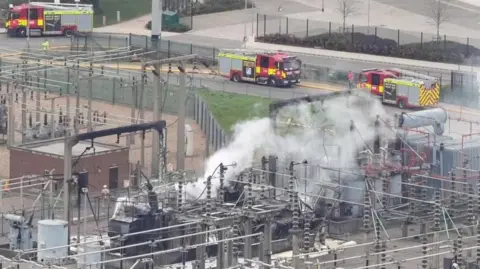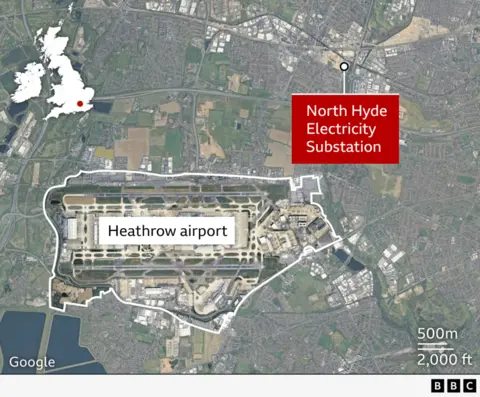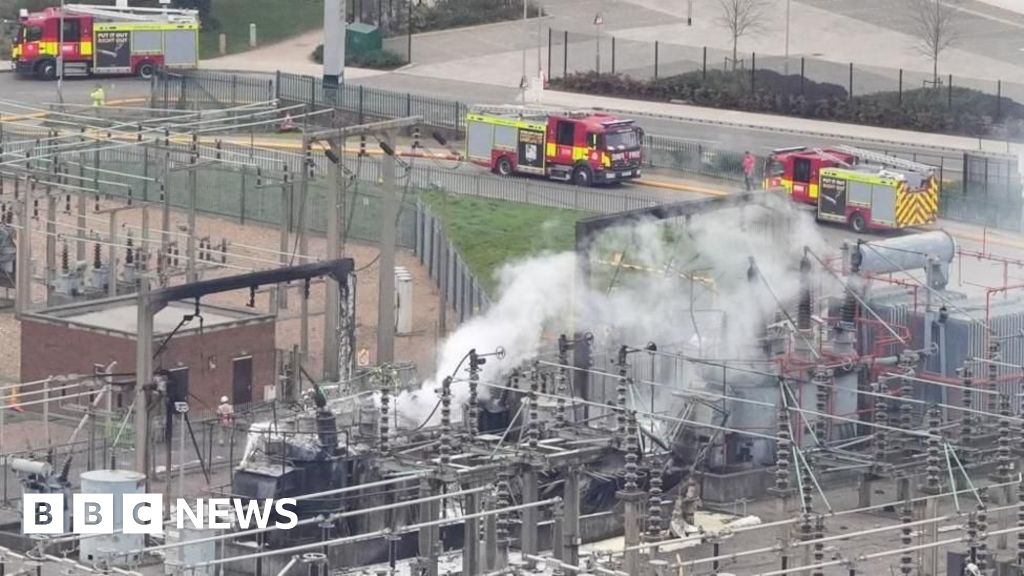Business reporter, BBC News
 PA Media
PA MediaIssues at an electrical substation which caused a fire that resulted in Heathrow Airport closing were first detected seven years ago but not fixed, a report has found.
The National Energy System Operator (NESO) said moisture entering electrical components at the North Hyde substation caused the blaze at the site that supplies the UK’s biggest airport with power.
It revealed an elevated moisture reading had been first detected in July 2018, but the issue went “unaddressed” for years, with basic maintenance by National Grid cancelled.
Energy watchdog Ofgem launched an investigation into National Grid following the report’s findings, which Energy Secretary Ed Miliband calling “deeply concerning”.
The fire at the electrical substation in 20 March resulted in a major power cut, which affected 66,919 domestic and commercial customers, including Heathrow Airport.
The airport closed for the majority of the following day, which impacted about 270,000 journeys, with thousands of cancelled flights and stranded passengers.
Neso’s report established the fire was “most likely” caused by moisture entering electrical insulators known as bushings. The electricity likely then sparked, which ignited oil and caused a fire.
It said “elevated” moisture had been detected in July 2018 and that under National Grid’s guidance, such readings indicate “an imminent fault and that the bushing should be replaced”.
But it said the issue went “unaddressed” and an “basic maintenance” to fix the problem in 2022 was deferred.
The power failure resulting in the closure of Heathrow raised wider questions about the UK’s major infrastructure resilience.
‘Missed opportunities’
Neso said the impact beyond the airport was “significant”, with “essential services” including road, rail and Hillingdon Hospital affected, as well as businesses and thousands of homes, some of which had to be evacuated.
Fintan Slye, Neso’s chief executive, told the BBC’s Today programme that while the report “did not set out to apportion blame”, National Grid was responsible for the maintenance of the equipment and making sure it is fit for operation.
“So when they identified those moisture levels back in 2018, what should have happened is that the transformer should have been taken out of service for a short period of time and that fault effectively repaired,” he said.
“That was missed. The moisture got worse over time and ultimately that’s what caused the fire to happen. The story of our report really is probably one of missed opportunities.”
After announcing its investigation into National Grid, Akshay Kaul, director general for infrastructure at Ofgem, said it expected energy companies to “properly maintain their equipment and networks to prevent events like this happening”.
“Where there is evidence that they have not, we will take action and hold companies fully to account,” he added.
Energy Secretary Ed Miliband said the report was “deeply concerning”. “There are wider lessons to be learned from this incident,” he added.
In response to the report, National Grid said it had a “comprehensive asset inspection and maintenance programme in place” and that it had “taken further action since the fire”.
It said this included “re-testing the resilience of substations that serve strategic infrastructure” and added it would cooperate with Ofgem’s investigation.
Mr Slye said as well as the substation fault, there was also a “potential missed opportunity” at Heathrow to maximise its energy resilience and also another to across the energy industry around understanding resilience of critical infrastructure.
The report also said that “it was not known to the energy companies” that the loss of one of the electrical supply points – of which Heathrow has three – would result in a power outage to some of the airport’s critical systems.
“The review also found that energy network operators are not generally aware whether customers connected to their networks are Critical National Infrastructure,” it said.
Heathrow Airport welcomed the report and said it expected National Grid “to be carefully considering what steps they can take to ensure this isn’t repeated”.
“A combination of outdated regulation, inadequate safety mechanisms, and National Grid’s failure to maintain its infrastructure led to this catastrophic power outage,” the airport said.

While power was restored to Heathrow by 06:25 on 21 March using circuits from another nearby substation, the flow of electricity to all four of Heathrow’s passenger terminals was not restored until 10:56.
Flights did not resume until after 18:00 that day, once safety checks were completed. Planes were able to land and take off through the night to enable Heathrow to get back up to full capacity.
Nigel Wicking, chief executive of Heathrow Airline Operators’ Committee, told the BBC that Heathrow’s closure cost airlines between £80m-£100m.



